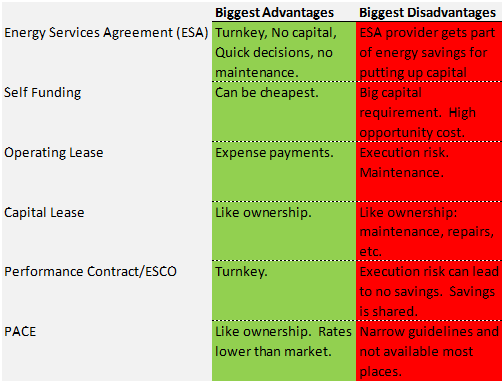ABOUT ENERGY SERVICES AGREEMENTS (ESAs)
Energy Services Agreements essentially outsource your energy in a way that saves you money. Outsourcing has proven to be effective in many areas where core experience and focus are an advantage. Think about payroll services, food services, custodian services, headhunting services, etc. These are areas where outsourcing has taken hold long ago.
The production and consumption of energy has been going through big changes in recent years, leading to a great opportunity for organizations to cut energy costs significantly. To seize the opportunity, however, it takes specialized knowledge, an experienced team of engineers, and new capital equipment.
Ordinarily something like this would take a management team’s time and focus away from their core mission. It would ordinarily require a significant amount of capital to get it off the ground. Capital that could perhaps be preserved, or put to better use on something core to the mission of the organization.
So if an ESA can 1. save you money, 2. doesn’t distract your management team, and 3. requires no upfront capital, then you have a winning formula. That’s why we partner with RENEW Energy Partners, a pioneer in specialized Energy Service Agreements (ESAs) that require no upfront capital.
Advantages of an ESA
Operating Expenditures Saved Through Lower Energy Costs
ESAs save money. Typical ESAs involve replacing old, inefficient energy-consuming assets with new, more efficient assets. Examples include boilers, cooling units, lighting, building controls, etc. Experience has shown that reductions in energy use of between 30% and 50% can be achieved.
Savings Start Sooner
By moving forward with your energy upgrade through an ESA today, you start to gain the benefits of lower energy costs right away. Contrast this with an alternative scenario where you move forward with an energy upgrade independently, but 2 or 3 years further in the future. This alternative means that you miss out on 2 or 3 years of energy savings.
Lower Environmental Impact
By achieving large reductions in energy consumption, the environmental impact of operations is proportionally reduced as well. Carbon emissions in particular are reduced, thereby lowering the carbon footprint of your operations.
Increased Valuation
With an ESA, energy costs are lower, which leads to operating expenditures being lower. Therefore the profitability of the organization is typically increased. Profitability is obviously one key metric that organizations look at, as is valuation, which is also typically higher as well. A building with new HVAC, lighting and controls is valued more highly.
No Added Debt, Preservation of Capital
If an ESA bundles in all the capital, then there’s no upfront capital that’s necessary. Therefore, there’s no debt added to the balance sheet. Capital gets preserved, or deployed in other ways.
Outsourced Maintenance, Repairs & Insurance
By entering into an ESA, an organization essentially outsources all the fixed costs (i.e. equipment capital costs, maintenance, and insurance) related to the energy production. Additionally, during the length of the ESA, the ESA provider covers any equipment repairs, if any.
Less Risk of Breakdown or Failure
An organization that operates old and inefficient capital equipment bears a substantially higher risk of failure. Not everything that can go wrong is evident through inspections, or avoided through routine maintenance. The higher risk of failure leads to a higher risk of incurring repair costs, as well as going without energy for a period of time while the repair is being made.
Full Scope of Improvements Outsourced
By having an experienced team plan and manage the improvements, and optimize those improvements to maximize savings, the heavy lifting needed to make these big improvements is not placed on management.
Leveraging Team of Experts
The ESA comes backed with an experienced team of experts who have completed these types of projects in the past. The team includes financial investors, industry experts, and channel partners such as product manufacturers, engineers, and general contractors.
ESA Payments Can Be Expensed
ESA payments can be treated as a capital expense or as an operating expense.
Disadvantages of an ESA
No Depreciation
The only potential downside to entering into an ESA is that the “buyer” organization doesn’t get to depreciate the cost of the equipment. Of course, in most cases the equipment that’s being replaced is already fully depreciated, so there’s no depreciation impact in the financial statements of the organization.
Of course, if the buyer of the ESA invests in capital or labor instead of spending on the energy assets, that disadvantage is greatly mitigated, or even eliminated.
How an ESA is Priced and Paid For
With a RENEW Energy Partners ESA, no upfront payments are required. Energy audits (including a review of historical energy consumption), planning, and construction costs are all bundled into the ESA. Payments under the ESA are only a portion of the savings, so the organization making those payments is net cash flow positive from the start. The organization continues to pay its utility bills directly to the utility, which become lower, of course, after the investment in high-efficiency equipment is completed.
At the end of the term, the building owner can buy the project at fair market value or renew the ESA.


